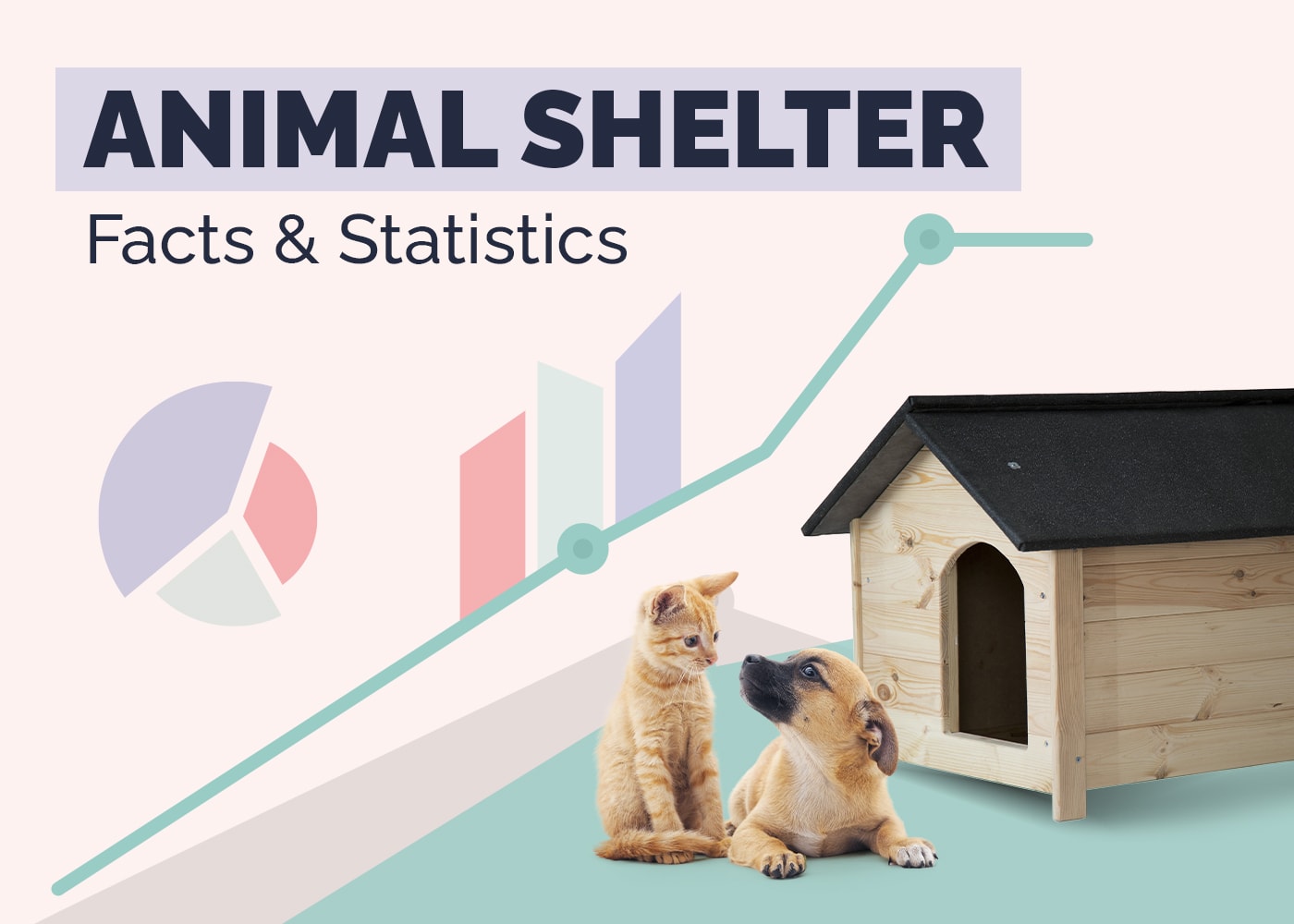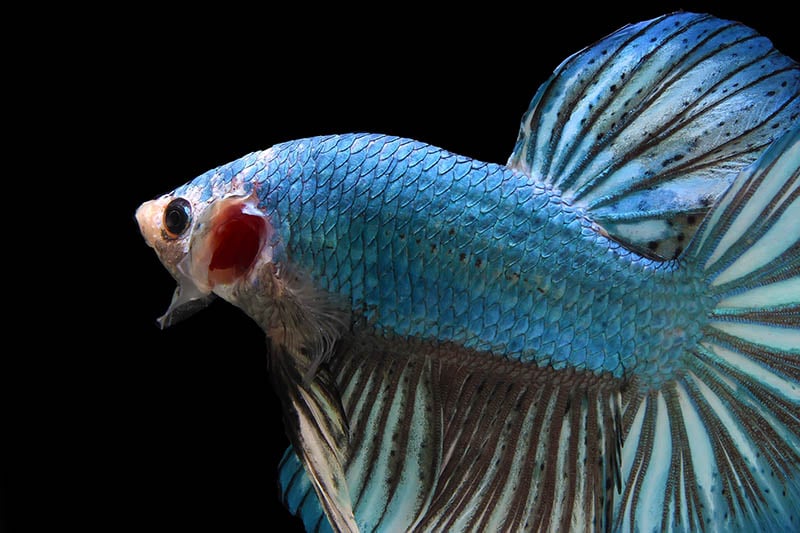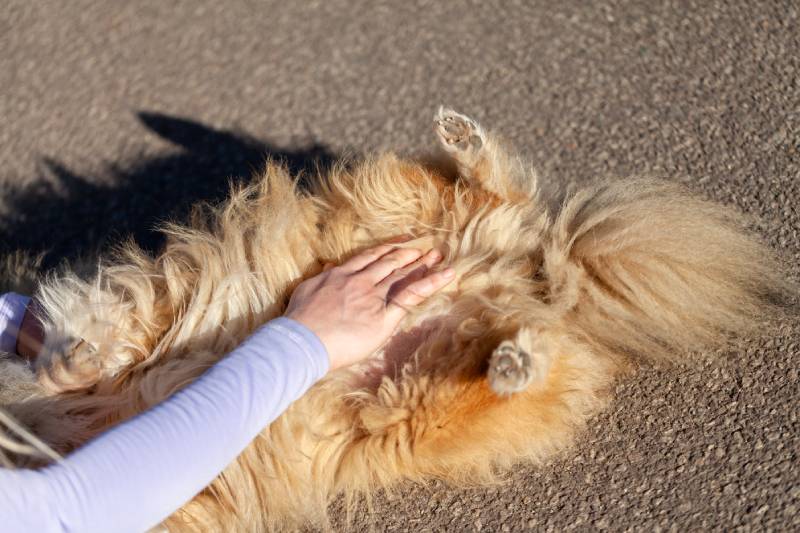26 Shocking Animal Abuse Statistics & Facts (Updated in 2024)

Updated on
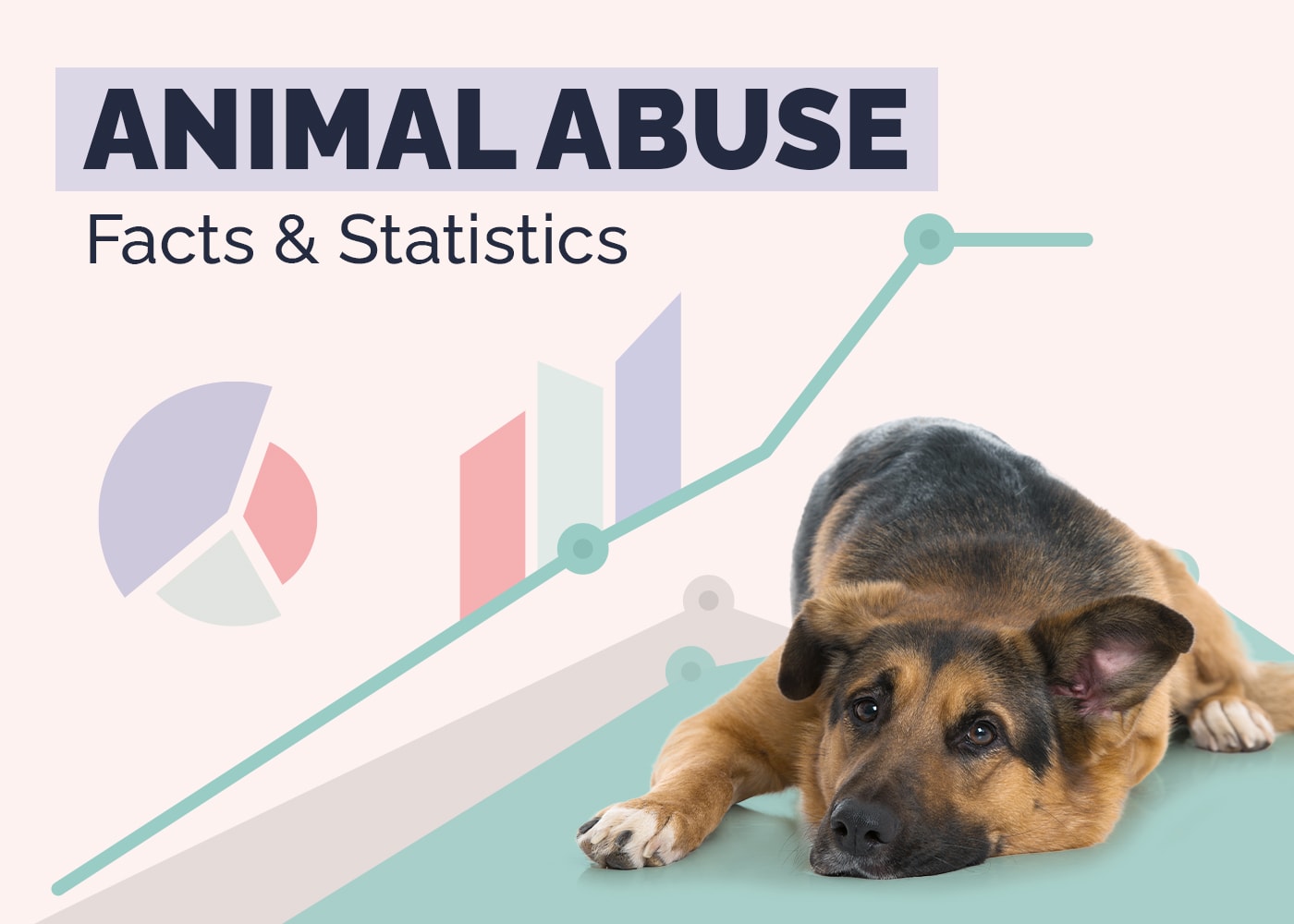
Click to Skip Ahead
Note: This article’s statistics come from third-party sources and do not represent the opinions of this website.
Many people prefer not to discuss the topic of animal abuse, especially when your love for animals runs deep. However, having discussions about this shocking truth is one way to spread awareness and knowledge, and with knowledge comes power.
Animal abuse is also more involved than we may realize, and the frequency and severity of the abuse are incomprehensible. The statistics and facts are shocking, but they can motivate more people to look for solutions to eliminate animal abuse.
The 26 Animal Abuse Statistics & Facts
- An animal is abused every minute, all around the world.
- Every year, 10,000 animals are abused to death in the United States.
- The RSPCA receives a call for help every 30 seconds.
- Men under 30 are most likely to abuse animals.
- Asia has the highest rate of animal abuse.
- Dogs make up 65% of animals that are suffering abuse.
- The most commonly abused dog breed in the world is the Pit Bull.
- 71% of people involved in domestic violence have also used animals or pets as their victims.
- Animal Hoarding is one of the most shocking forms of animal cruelty. It primarily affects cats and dogs.
- There are over 10,000 puppy mills in the United States.
- In the US, 6.3 million animals enter shelters annually.
- Approximately 75% of tortoises and turtles, lizards, and snakes die within a year after becoming pets.
- Every year, many dogs die from being left alone in hot cars.
- Farm animals make up 97% of abused animals.
- Dairy cows on farms produce 10 times more milk.
- Millions of baby chicks are killed because they are deemed worthless.
- Mother pigs become so cramped on factory farms that they are unable to turn around.
- Helpless animals used for testing are often poisoned, burned, crippled, or killed.
- Over 100,000 dogs are used in tests in US laboratories each year.
- Every year, approximately 100 million animals are bred and killed for fur.
- Over 100,000 horses are killed annually for human consumption.
- Some circuses force Tigers to jump through fiery hoops, despite their fear of fire, and some end up burned because of this.
- Trainers use painful tools to force circus animals to perform.
- About 95% of a circus animal’s life is spent in cages or chains.
- Over 35,000 elephants are poached every year for ivory.
- Approximately 8,500 tigers are held captive.
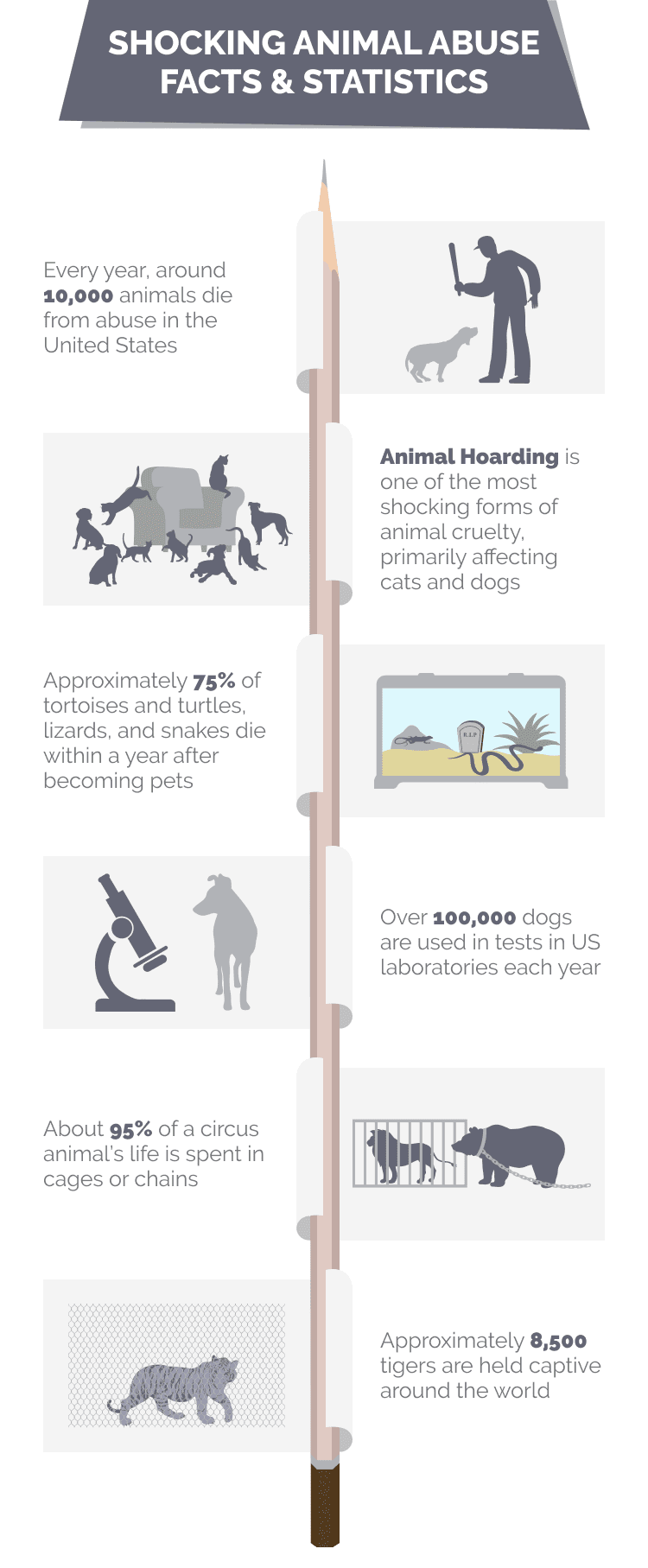
General Animal Abuse Statistics
1. An animal is abused every minute, all around the world.
(National Today)
The rate of animal abuse is still so widespread, and its frequency is shocking. Every minute that passes, an animal is abused, which means by the time you have finished reading this, approximately 5 to 10 animals will have suffered some form of abuse somewhere in the world.
2. Every year, 10,000 animals are abused to death in the United States.
(PETA)
Abuse is one thing, but to be abused to the point of death is deeply disturbing. 10,000 animals of all kinds are abused to death each year in the US. This includes numerous industries such as testing, farming, fighting, and medicine. What is scary is that a lot of the abuse that happens is not even reported, which could change this statistic to a shockingly higher number.
3. The RSPCA receives a call for help every 30 seconds.
(Lad Bible)
The RSPCA is a non-profit organization that gets a call every 30 seconds for help. That is enough to reveal how much abuse is taking place on a daily basis. What’s really sad about this situation is that the organization has to prioritize cases where the law is being broken because of the volume of calls.
4. Men under 30 are most likely to abuse animals.
(Humane Society)
A lot of animal cruelty is seen among men under 30. Generally, abusive crimes are carried out by men, and animals can be used as a tool in domestic violence.
5. Asia has the highest rate of animal abuse.
(Animals Asia)
Animal abuse is common and widespread in Asia, making Asian animals among the most abused in the world. This abuse ranges from dogs and cats slaughtered in brutal ways for their meat to bears captured and caged for their coats. Each year, it is estimated that 10 million dogs and 4 million cats are slaughtered for their meat in China alone. In comparison to other continents, Asia sadly has far fewer laws protecting animals from cruelty and exploitation.
Pet Abuse Statistics
6. Dogs make up 65% of animals that are suffering abuse.
(Fabiosa)
Dogs, known as man’s best friend, are the most common pets around the world. There are also areas of the world where dogs are overpopulated due to not being spayed and neutered, and a lot of these dogs will end up in shelters or homeless. Dogs that have been abused can receive abuse through domestic violence, neglect, abandonment, breeding, and fighting.
7. The most commonly abused dog breed in the world is the Pit Bull.
(MI Dog Guide)
Pit bulls are considered the strongest fighting dogs because of their desire to please their owners, their strength, and their tolerance for pain. Not only is the sport of dog fighting a shocking form of abuse, but so is the way these dogs are treated. The people responsible for fighting the dogs abuse them, torture them, and even use them for bait. Dog fighting is why pit bulls are the most commonly abused dog breed in the world.
8. 71% of people involved in domestic violence have also used animals or pets as their victims.
(Humane Society)
Often pets of domestic violence victims become victims themselves. That is because the perpetrator will use the bond between their victim and their pet to control and manipulate the situation. Sadly, many victims of domestic violence won’t leave the relationship or will return to the relationship because of their concern for their pets.
9. Animal Hoarding is one of the most shocking forms of animal cruelty. Affecting mostly cats and dogs.
(ALDF)
Approximately 250,000 animals are victims of hoarders every year, and that number is growing. Animals that are victims of hoarders often suffer from malnourishment, untreated medical conditions, and psychological stress and trauma. Most hoarders are women, and the most affected animals are cats and dogs.
10. There are over 10,000 puppy mills in the United States.
(Fabiosa)
Puppy mills are essentially factories that produce puppies in large numbers and in shocking conditions. A lot of abuse takes place in the form of mistreatment, inadequate care, and the failure to identify genetic mutations. It’s saddening to know that over 10,000 puppy mills are operating in the US.
11. In the US, 6.3 million animals enter shelters annually.
(ASPCA)
Approximately 6.3 million animals enter US shelters every year. About 3.2 million are dogs, while 3.2 million are cats. Each year, approximately 920,000 sheltered animals are euthanized.
12. Approximately 75% of tortoises and turtles, lizards, and snakes die within a year after becoming pets.
(World Animal Protection)
Any wild animal that becomes a pet will experience some form of suffering. It is difficult to meet the same needs that the animal experiences in its natural environment, and every year, thousands of wild animals are captured and bred in captivity to be sold as pets.
13. Every year, many dogs die from being left alone in hot cars.
(PETA)
PETA receives several reports annually about dogs being left in hot cars. In 2022, 54 animals were victims of heat-related deaths, and 469 were rescued. These numbers are obtained from the reported cases, which means they are likely higher.
Their Pain for society’s Gain
14. Farm animals make up 97% of abused animals.
(Last Chance for Animals)
Factory farming mass-produces animals for meat and the products they generate, such as eggs and milk. Factory farming is a business, and its success relies on mass production and cutting costs, which means the animals are usually confined, drugged, and treated poorly. These abused farm animals make up a shocking 97% of abused animals.
15. Dairy cows on farms produce 10 times more milk.
(LCA)
A dairy cow’s purpose is to produce milk, but with a high demand for this product, they are forced to produce 10 times the milk they would naturally make. This results in numerous health issues and mistreatment. The machines used to milk these cows often cut and injure them, and the conditions where the cows are kept are overcrowded. A cow living naturally in its environment will live up to 25 years, but dairy cows are usually killed when they are about 5 years old, and their meat is used for fast food.
16. Millions of baby chicks are killed because they are deemed worthless.
(Animal Abuse)
Millions of chicks as young as a day old are killed in high volumes because they are worthless to the egg industry. When chicks are born, they get placed onto a conveyor belt where a worker separates them by sex. The male chicks are discarded and thrown into trash bags where they suffocate, are ground up alive, or decapitated.
17. Mother pigs become so cramped on factory farms that they are unable to turn around.
(World Animal Protection)
Like other animals on factory farms, the environment for mother pigs is cramped and confined in cages. During pregnancy, they are confined to areas known as gestation crates. These crates are so small, usually the size of an average refrigerator, that the mother pigs can’t even turn around.
18. Helpless animals used for testing are often poisoned, burned, crippled, or killed.
(PETA)
Every year, over 111 million mice and rats are killed in laboratories in the United States. The abuse varies from being poisoned, burned, and traumatized from psychological experiments that induce terror. Experimental surgeries leave them mutilated, pain studies involve electroshocking, and drug studies expose them to dangerous substances like cocaine.
19. Over 100,000 dogs are used in tests in US laboratories each year.
(PETA)
Every year, nearly 65,000 dogs are used in laboratories in the United States. They are harmed for human disease research, and toxicology studies still occur today, where dogs are slowly poisoned to death. This is only a sample of what goes on.
20. Every year, approximately 100 million animals are bred and killed for fur.
(HSI)
Every year, 100 million animals are slaughtered on intensive fur farms to supply the fashion industry. The fur is not only used for coats but for pom poms on beanies, fur-trim hooded jackets, shoes, gloves, and more.
21. Over 100,000 horses are killed annually for human consumption.
(Humane Society)
Yes, you heard right, horse meat is a staple for some people. Because of its low cost and resemblance to beef, horse meat is easily hidden in sausages and ground meat. These horses are shipped in crowded trucks for more than 24 hours at a time without food, water, or rest, and they usually suffer injuries or die. They are often subjected to repeated blows and may stay conscious during dismemberment, making their death a slow and painful one.
Wild Animal Abuse Facts & Statistics
22. Some circuses force Tigers to jump through fiery hoops, despite their fear of fire, and some end up burned because of this.
(PETA)
Tigers are terrified of fire, but they are trained to jump through hoops of fire in circuses, usually by being whipped or beaten. Fortunately, circuses are not as popular, and several have gone out of business.
23. Trainers use painful tools to force circus animals to perform.
(Do Something.org)
Circus performers who use animals for their shows use abusive methods to train them. They are usually forced to perform by being trained with muzzles, whips, electric prods, bullhooks, tight collars, and other painful tools.
24. About 95% of a circus animal’s life is spent in cages or chains.
(Do Something.org)
Wild animals in a circus have to be transported from state to state, and to get them to their next performance venue, they usually travel in boxcars where they are chained. Furthermore, these spaces have no climate control, which means that these poor animals must endure extreme weather conditions.
25. Over 35,000 elephants are poached every year for ivory.
(BBC)
Elephants are hunted across Africa by poachers for their ivory tusks, which are used to create jewelry and ornaments. Each year, over 35,000 elephants are poached, which often results in death.
26. Approximately 8500 tigers are held captive.
(EIA International)
Tiger body parts are in high demand as medicines and decorative items, especially in China. Sadly, The Chinese tiger farm business model has been emulated elsewhere, and there are now over 8,500 captive tigers in China, Laos, Thailand, Vietnam, and South Africa. The setting of these tiger farms ranges from filthy backyards and basements to operations where speed-breeding is a priority.
FAQ
What are the different types of animal cruelty?
There are two primary categories of animal cruelty: neglect and abuse. Abuse is the intentional act of causing harm to an animal, while neglect is the failure to provide an animal with proper care. An animal can be abused by hoarding, mutilating, burning, neglect, fighting, and beating to name a few. Any instance where an animal is not provided adequate care and is intentionally harmed is considered abuse.
How can we stop animal cruelty?
While eradicating animal cruelty is still far from possible, there are some minor changes each individual can make. You can start by keeping meat off your plate and stop supporting the farming industry. Be a responsible pet owner, and report any cases of abuse you may suspect or witness. If you have children, teach them how to respect animals and get them involved in volunteering at shelters.
What are animal rights?
Animal rights are moral principles that safeguard the autonomy of animals from being subjected to abuse for human gain. These principles protect the animal’s freedom. A few countries have incorporated animal rights into law along with essential protections and guidelines. Some examples may include:
- Animals cannot be bred
- Animals may not be hunted
- Animals may not be used for food
- The animals’ habitat must be protected so they can live as they choose.
Conclusion
Animals don’t have a voice, so it’s up to us to step up and fight for their rights. While this problem is so widespread and overwhelmingly extensive, there are small things we can do to start making a difference. You can stop supporting circuses and places where you are unsure how the animals are looked after. You can also adopt a pet instead of visiting a pet store, and you can keep more meat, eggs, and dairy off your plate to protest the unethical treatment of farm animals.
More importantly, report any abuse you may witness or suspect, as it can make the difference between life or death for that animal.



